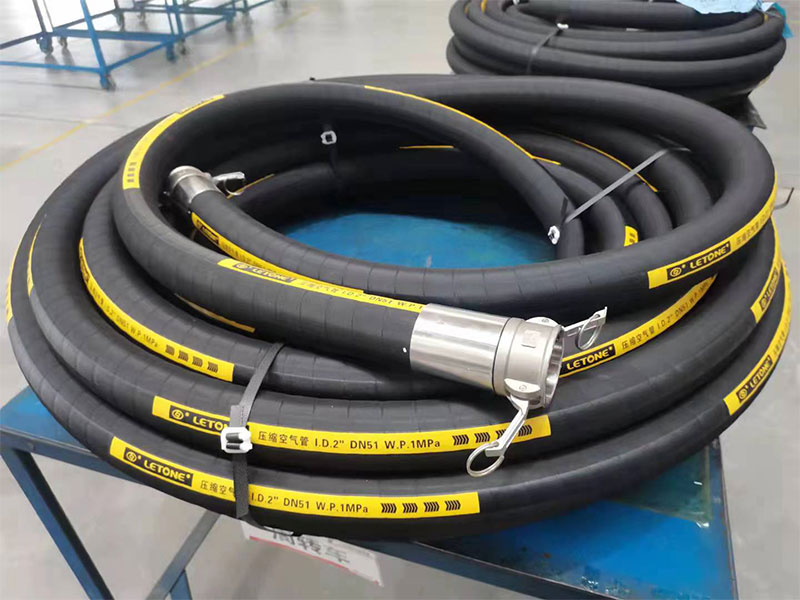2025-05-20 15:41:22
Mining oil hose: technical characteristics
1、 Technical structure: Collaborative design of multi-layer composite materials and reinforced skeleton
The mine oil hose adopts a sandwich structure of "inner rubber layer reinforced layer outer rubber layer", which achieves functional zoning through material science. The inner rubber layer is made of nitrile rubber (NBR) or hydrogenated nitrile rubber (HNBR), which has oil resistance and can resist the erosion of mineral oil, hydraulic oil and other media, while maintaining a wide temperature range stability from -40 ℃ to 120 ℃. The reinforcement layer is the core of the pressure bearing capacity of the hose, and the steel wire winding structure forms a spatial mesh skeleton through multiple layers of cross weaving. For example, the "4SP" type hose uses four layers of steel wire winding, which can withstand a maximum pressure of 60MPa. The outer rubber layer is made of chloroprene rubber (CR) or polyurethane (TPU), which has both wear resistance and UV aging resistance. It can resist rock friction and chemical corrosion in mine tunnels.
Under extreme working conditions, hoses must meet special design requirements. For example, deep-sea mining hoses need to withstand external water pressure of over 10MPa, and their reinforcement layer adopts a high modulus polyethylene fiber and steel wire composite structure, with an axial flexibility increase of 30% to adapt to the movement of the mining machine. The throttling and killing hose of API 16C standard increases the blasting pressure to 155.3 MPa by adding a stainless steel braided layer, ensuring the safety of well control during the drilling process.
2、 Application scenario: Full coverage from mines to oceans
Mine hydraulic system
In the fully mechanized mining face, hoses need to be connected to hydraulic supports and pump stations to withstand frequent pulse pressures. For example, a certain mining hose has a specification of 6SP-76-70, an inner diameter of 51mm, and a working pressure of 213MPa, which can meet the power transmission needs of equipment such as coal mining machines and scraper conveyors. Its design with a minimum bending radius of 1800mm allows for flexible placement in narrow tunnels.
oil rig
As a key component of the top drive system, the drilling water hose needs to transport mud containing solid particles. A certain type of hose adopts a double-layer steel wire winding structure, with an inner wire diameter of 0.8mm and an outer wire diameter of 1.2mm, with a tensile strength of 1500MPa, and is quickly connected with a union joint. In high-temperature well conditions, flame retardant is added to the outer rubber layer of the hose, with an oxygen index of ≥ 28%, in compliance with API 16D standard.
Deep sea mineral development
In the collection system of polymetallic nodules, the hose needs to meet both external and internal pressure requirements. The length of a deep-sea hose reaches 5000m, and through segmented reinforcement design, it can still maintain cross-sectional stability at 1000m underwater. Its dynamic response test shows that when the mining machine moves at a speed of 2m/s, the stress concentration factor of the hose decreases to 1.2, and the fatigue life is extended to 2000 cycles.
3、 Performance optimization: material innovation and process upgrading
Lightweight and corrosion-resistant
The density of polyurethane based hoses is reduced to 1.2g/cm ³ by adding nano silica fillers, which is only 1/8 of that of steel pipelines. After soaking a certain type of mining hose in an acidic and alkaline environment for 1000 hours, the quality loss rate is less than 0.5%, and the tensile strength retention rate is greater than 90%. Its conductive fiber implantation technology makes the surface resistivity ≤ 1 × 10 ⁶ Ω, meeting the explosion-proof requirements of coal mines.
Joint sealing technology
The card sleeve joint achieves zero leakage through a three-stage structure: the conical surface of the joint body forms a mechanical seal with the outer edge of the card sleeve, the O-ring compensates for thermal expansion, and the control accuracy of nut pre tightening force reaches ± 5%. In high-pressure testing, a certain type of joint cycled 100000 times under a pressure of 42MPa, with a leakage rate of less than 0.1mL/min.


Leave a Comment